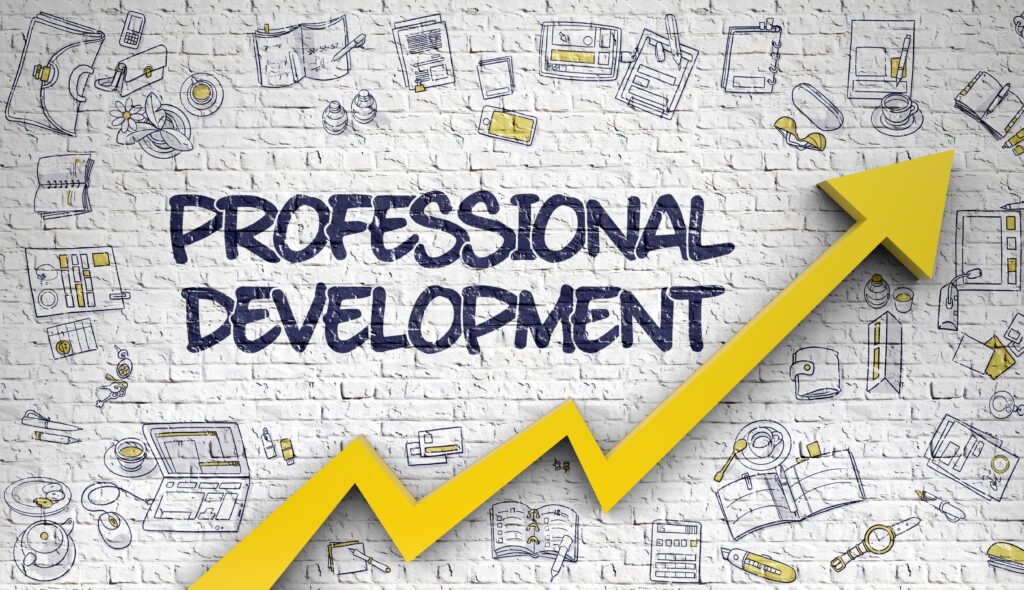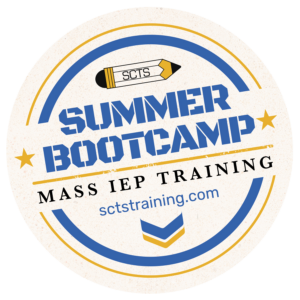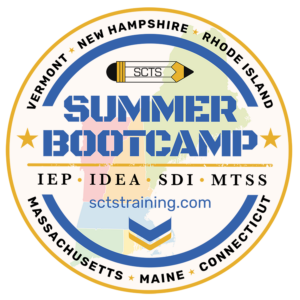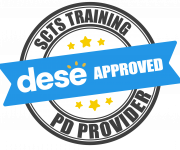
IEP Development and Service Delivery under IDEA
IEP Development and Service Delivery under IDEA is a comprehensive asynchronous learning course for all educators to learn the skills necessary to develop strong Individual Education Programs (IEPs) and support best outcomes for Students with Disabilities.
This training course offers a multitude of opportunities by equipping educators with essential knowledge to effectively address the diverse needs of Students with Disabilities. Through comprehensive training in special education, state and federal regulations, IEP development, and evidence-based practices, educators will become better prepared to understand the special education process and develop comprehensive IEPs that promote inclusive education in the least restrictive environment while fostering student success. Strategic Calibration Training Systems empowers school districts to prepare a strategic plan that prioritizes the ever-changing regulatory requirements in special education and builds capacity for educators in the science of IEP development and service delivery.
SCTS prioritizes students in the Team process. Teams will have the opportunity to revisit their current practice and recalibrate their work in the adaptation of new learning guided by the Individuals with Disabilities Education Act, also known as IDEA. The SCTS formula focuses on the strengths and needs of students, recognizes parents as partners, provides voice to all stakeholders, and fosters an inclusive and supportive educational experience that enhances the academic and social outcomes for Students with Disabilities as members of their individual learning communities.
- Self-guided / Online
- Open Enrollment
DESE Approved PD Provider

Special Education Professionals & Leadership
Learning method
Self-paced training series designed to provide support and education to owners, managers, and peer supports about best practices within the recovery home environment.
Self-Paced Online Course
Contact for Pricing
No instructor. Study on your own schedule
IEP Development and Service Delivery under IDEA
We aim to achieve the following through our IEP Training Courses:
- Enhanced Expertise
- Improved Student Outcomes
- Inclusive Classroom Environments
- Legal Compliance
- Self-Paced Individual or Group Led
- Enhanced Compliance
- Improved Resource Allocation
- Enhanced Collaboration
- Data-Driven Decision-Making
Course Outline
IEP Development and Service Delivery under IDEA is a comprehensive asynchronous learning course for all educators to learn the skills necessary to develop strong Individual Education Programs (IEPs) and support best outcomes for Students with Disabilities.
Introduction to The IEP
- Welcome to SCTS Training
- Key Features of the IEP with Strategic Calibration Training Systems
- Definitions
- IDEA – The Individuals with Disabilities Education Act
- The Four Subchapters of IDEA
- The History of Free and Appropriate Public Education
- IDEA B: Educating Learners ages 3-21
- Meet Grady, Our AI Developed Student
- Sections of the IEP under IDEA – About this Course
- Responsive Teams
- Check for Understanding: Introduction to The IEP
Getting Started with The IEP
- Calibration of Practice
- IEP Meeting Structure & Purpose
- Sample IEP Meeting Agenda
- The IEP Team
- IEP Team Members & Special Education Collaborators
- Questions for Discussion
- Check for Understanding: Getting Started with IEP
Developing the IEP
- Developing the IEP: Introduction
- SCTS IEP Theme
- SCTS IEP Theme: Claims
- Video: Supporting Claims with Data: 10 Data Sources
- SCTS IEP Theme: Strengths
- Video: Creating Strength Based IEPs
- SCTS IEP Theme: Needs
- Video: 4 Key Components to Understanding Student Needs
- SCTS IEP Themes Summary
- Check for Understanding: Developing the IEP
Unit 1: Student & Parents Concerns
- Introduction: Student and Parent Concerns
- Grady’s Student & Parent Concerns
- Application: Student & Parent Concerns in the IEP
- Preparing for the Student & Parent Concerns in the IEP
- IEP Checklist: Student & Parent Concerns
- Activity: Grady’s IEP Student & Parent Concerns
- Check for Understanding: Student & Parent Concerns
Unit 2: Student & Team Vision
- Introduction: Student & Team Vision
- Grady’s Student & Team Vision
- Preparing for the Student & Team Vision in the IEP
- IEP Checklist: Student & Team Vision
- Activity: Grady’s IEP Student & Team Vision
- Check for Understanding: Student & Team Vision
Unit 3: Category of Disability, Student Profile & Special Factors
- Introduction: Category of Disability & Special Factors
- Developing a Student Profile
- Student Profile Examples
- Special Factors
- Special Factors 1 & 2: Behavior & Limited English Proficiency
- Special Factors 3 & 4: Vision impairment & Communication Needs
- Special Factors 5: Assistive Technology Devices & Services
- IEP Checklist: Category of Disability, Student Profile & Special Factors
- Check for Understanding: Category of Disability, Student Profile, & Special Factors
Unit 4: Presents Levels of Academic & Functional Performance (PLAAFP)
- Introduction: Present Levels of Academic & Functional Performance (PLAAFP)
- SCTS IEP Theme, Strengths & Needs
- PLAAFP: Academics
- PLAAFP: Behavioral/Social/Emotional
- PLAAFP: Communication
- PLAAFP: Additional Areas
- Grady’s Student Profile & PLAAFPs
- Preparing for the Present Levels of Academic & Functional Performance
- IEP Checklist: PLAAFP
- Activity: Grady’s IEP Student Profile & Present Levels
- Check for Understanding: PLAAFP
Unit 5: Where’s The Data?
- Introduction: Where’s The Data?
- Where’s The Data Activity: Tier II & III Assessments
- Where’s The Data: Common Tier 2 & 3 Elementary ELA Assessments
- Check for Understanding: Where’s The Data?
Unit 6: Accommodation, Modifications, & Assessment
- Introduction to Accommodations and Modification
- Accommodations
- Modifications
- State or District-wide Assessment / Alternative Assessment
- Preparing for Accommodations, Modifications, & State Assessment
- A Word from Grady and his Teachers on Accommodations and Modifications
- Activity: Accommodations vs Modifications
- IEP Checklist: Accommodations & Modifications
- Activity: Grady’s IEP Accommodations & Modifications
- Check for Understanding: Accommodation, Modifications, & Assessment
Unit 7: IEP Goal Writing
- Goal Writing: Overview
- Introduction: IEP Goal Writing
- Standard IEP Goal Writing Formula
- Goal Writing Method 1
- Goal Writing Method 2
- Writing Effective IEP Goals
- Measurable Annual Goals
- Sample Goals: Reading (Decoding and Encoding)
- Sample Goals: Self Advocacy
- Sample Goals: Math
- Sample Goals: Written Expression
- Preparing for IEP Goal Writing
- Grady’s Measurable Annual Goals
- IEP Checklist: Measurable Annual Goals
- Check for Understanding: Goals & Objectives
Unit 8: Access to The General Curriculum, IEP Service Delivery, & Transportation
- Introduction: Access to The General Curriculum, IEP Service Delivery, & Transportation
- Participation in the General Education Setting
- IEP Service Delivery – Service Grids
- IEP Service Delivery – Determining IEP Services & Service Minutes
- Transportation Services
- Schedule Modification
- Service Delivery for Extended School Year Services
- Preparing for Access to the General Curriculum, IEP Service Delivery, and Transportation
- Grady’s LRE and Service Delivery
- Activity: Grady’s IEP Service Delivery
- IEP Checklist: Service Delivery
- Check for Understanding: Access to the General Curriculum, Service Delivery & Transportation
Unit 9: Transition Planning
- Introduction: Transition Planning
- Postsecondary Planning in the IEP
- Massachusetts: Graduation, Community Agencies, & Transfer of Rights
- Transition Planning Videos
- Transition Planning: Summary
- Transition Planning Resources & Assessments
- IEP Checklist: Transition Planning
- Activity: Transition Planning Guide
- A Word From Grady on Transition Planning
- Activity: Course of Study Worksheet
- Check for Understanding: Transition Planning
Unit 10: Additional Information
- Introduction: Additional Information
- IEP Response Section
- Grady’s Additional Information
- Activity: Grady’s IEP Additional Information
- Grady’s IEP Response Section & Placement Consent
Unit 11: Specially Designed Instruction under IDEA
- Introduction: Specially Designed Instruction
- Background Information: Definitions & Purpose with SDI
- What is Specially Designed Instruction?
- Content, Methodology, In Delivery of Instruction
- SDI In the classroom: Spiral Teaching and Entry Points for Grade Level Standards
- SDI in the IEP
- Activity: Content, Methodology, & Delivery of Instruction
- Check for Understanding: Specially Designed Instruction
Unit 12: IDEA and the 50 States
- IDEA & Department of Education Websites for all 50 States
- IEP Documents for all 50 States
- State Resources
Course Completion
- Grady’s IEP Review
- IEP Course Completion Exam
- Feedback & Discussion
- Download Certificate
IEP Implementation Resources
- IEP Under IDEA Resources & Downloads
- IEP Meeting Videos
- Downloads: Tier II / Tier III Assessments
- Recommended Reading
- Culturally Responsive Teaching and IEP Meeting Resources
- IEP Goal Calibration Table
- Leadership / Management Resources & Downloads
- Teams Resources & Downloads
- Communication Resources & Downloads
Support: 3 Ways to Get the Help You Need
Contact SCTS Support in one of the following 3 ways – and we will have one of our support specialists reply as soon as possible. All requests are replied to in the order they are received. Requests received before 1pm will be replied to the same business day. Requests received after 2pm will be replied to the following business day.
Technical Requirements for Our Online Courses
To successfully participate in an online course, the following technical requirements should be met:
1. Device Compatibility
- Computer: A desktop or laptop with a modern operating system (Windows 10 or later, macOS 10.13 or later).
- Mobile Device: A smartphone or tablet with Android (version 8.0 or later) or iOS (version 13.0 or later).
- Screen size of at least 10 inches is recommended for optimal viewing and navigation.
2. Internet Connection
- A stable internet connection with a minimum download speed of 5 Mbps.
- For live sessions or videos, a faster connection (10 Mbps or higher) is recommended.
3. Browser Requirements
- The latest version of Google Chrome, Mozilla Firefox, Microsoft Edge, or Safari.
- JavaScript and cookies must be enabled.
4. Software Requirements
- PDF reader (e.g., Adobe Acrobat Reader) for accessing course materials.
- Word processing software (e.g., Microsoft Word or Google Docs) for completing assignments.
- Zoom or similar applications may be required for live sessions or webinars.
5. Audio and Video
- Speakers or headphones for listening to lectures or videos.
- A microphone and webcam (built-in or external) for interactive sessions or discussions, if applicable.
6. Other Considerations
- Adequate storage space to download course materials if needed.
- Ability to access a reliable email account for course communications and updates.
These requirements ensure smooth access to course content and effective participation in all activities.




